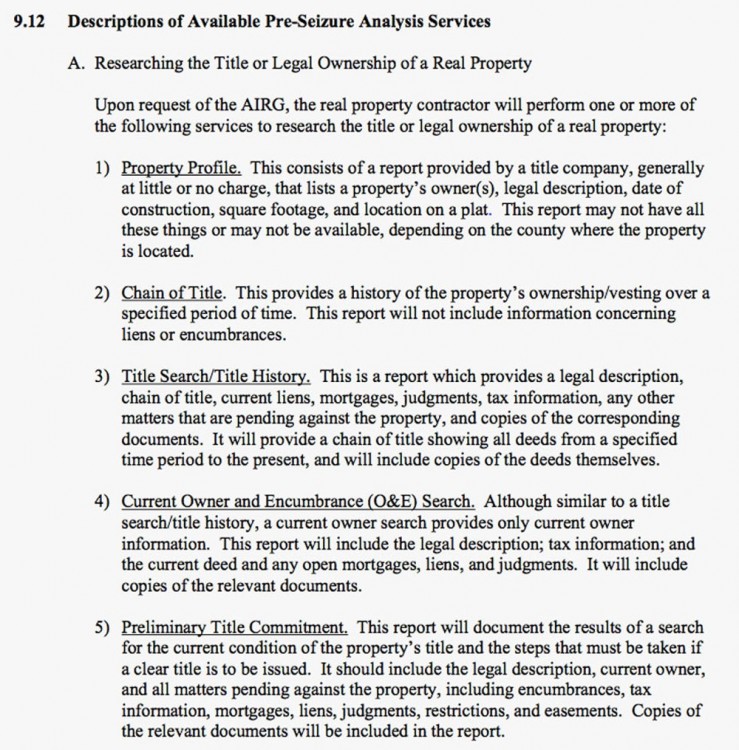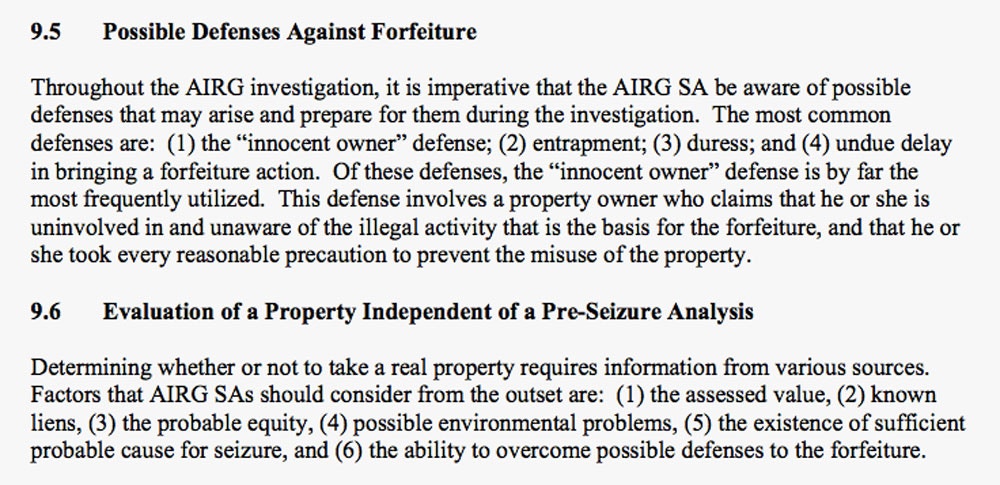
An internal handbook obtained by The Intercept provides a rare view into the extensive asset seizure operations of ICE’s Homeland Security Investigations, an office that trains its agents to meticulously appraise the value of property before taking it.
HSI’s 71-page “Asset Forfeiture Handbook,” dated June 30, 2010, underscores the role seizures play in “helping to fund future law enforcement actions” and covering costs “that HSI would otherwise be unable to fund.” It thus offers an unprecedented window into ICE’s wide-ranging asset forfeiture operations and the premium the agency places on seizing valuable property. Forfeiture proceeds can bolster ICE’s partnerships with local police departments, which are now the subject of heightened debate given the Trump administration’s hard-line immigration agenda.
ICE confirmed to The Intercept that the handbook reflects the agency’s most up-to-date guidance on asset forfeiture. Agents under its instruction are asked to weigh the competing priorities of law enforcement versus financial profit and to “not waste instigative time and resources” on assets it calls “liabilities” — which include properties that are not profitable enough for the federal government to justify seizing. “As a general rule, if total liabilities and costs incurred in seizing a real property or business exceed the value of the property, the property should not be seized,” the document states.
The handbook also instructs ICE agents on the various ways laws can be used to justify the seizure of a property, and devotes a significant portion of its pages to the seizure of real estate. The manual instructs agents seeking to seize a property to work with confidential informants, scour tax records, and even obtain an interception warrant to determine whether “a telephone located on the property was used to plan or discuss criminal activity” in order to justify seizing the property.
The handbook acknowledges that civil forfeiture can be used to take property from a person even when there’s not enough evidence for a criminal indictment. There “may be third party interest that would prevail in a criminal case, but would not survive in a civil proceeding, making the civil proceeding essential to forfeiture,” the handbook states, referencing a property owner not officially implicated in a crime. “Those situations generally occur when a property owner is not convicted of a crime but is also not an innocent owner. Under criminal forfeiture, that property owner would be entitled to the return of the property. Under civil forfeiture, however, the owner would lose his or her interest to the Government.”
Noting that ICE is not alone among federal agencies in relying on asset forfeiture, ICE spokesperson Danielle Bennett told The Intercept in a statement, “Asset forfeiture is an essential element of comprehensive and effective law enforcement as it deprives transnational criminal organizations of their illicitly obtained assets. The forfeiture of assets can be and is utilized as a sanction in criminal, civil, and administrative investigative activities.”
The Department of Homeland Security has seized billions of dollars in assets over the last decade, with the bulk of the revenue coming from investigations overseen by ICE. While the agency is best known for its role in immigration enforcement — carried out chiefly by officers in its Enforcement and Removal Operations division — its lesser-known HSI component has a much broader mandate, enforcing more than 400 criminal statutes with a nexus between cross-border crime and transnational criminal organizations, including human trafficking and smuggling, child pornography, terrorism, counterfeit goods, and drug smuggling. With more than 6,000 agents working in 185 field offices across the country and 63 locations overseas, HSI has the second-largest number of federal agents on the FBI’s Joint Terrorism Task Forces and has played a key role in numerous high-stakes investigations over the years. To fulfill its missions, which often involve undercover infiltrations, multi-year probes, and occasionally multimillion-dollar seizures, HSI agents have access to powerful intelligence and data systems that link federal law enforcement to the CIA and the Pentagon’s Defense Intelligence Agency.
Despite its size and the sweeping scope of its work, HSI has managed to maintain a low profile in comparison to some of its federal counterparts. With the Trump White House turning virtually every undocumented immigrant in the country into a target for deportation, ICE’s role in law enforcement has become a topic of intense public debate and increasingly pulled HSI out of the shadows. The handbook obtained by The Intercept now offers a unique window into a key component of the agency’s quiet investigations.
Every year, DHS seizes millions of dollars in assets through the course of investigations — everything from cash and houses, to boats and cars. Those assets are directed into a forfeiture fund maintained by the Treasury Department. The revenue from the assets is then used to cover a range of costs related to forfeiture investigations, from storing actual seized items to paying informants. Under a program known as equitable sharing, the revenue is also used to award and reimburse state and local law enforcement agencies that participate in federal seizure-related investigations, which those agencies then use to purchase equipment, weapons, and other law enforcement technology.
Though multiple DHS agencies contribute to the Treasury forfeiture fund — such as Customs and Border Protection and the Secret Service — ICE leads the way both in seizures feeding into the fund and in payments doled out to state and local law enforcement. According to a 2014 report by the U.S. Government Accountability Office, from 2003 to 2013, DHS poured roughly $3.6 billion into the Treasury’s forfeiture fund. From 2007 on, the report found, ICE was “consistently” responsible for “approximately 50 percent or more of total forfeiture revenues by DHS components.” Over the 2003 to 2013 period, the GAO noted, “equitable sharing payments constituted the largest” obligation in the Treasury’s forfeiture fund, with approximately $1.2 billion paid out to “a range of state and local law enforcement agencies across the country — as well as other federal agencies and foreign entities — that participated in law enforcement efforts resulting in forfeitures.”
“Among the three DHS components making equitable sharing payments, ICE made up over 90 percent of total DHS obligations for equitable sharing payments,” the report added. “State and local agencies accounted for the majority of sharing recipients, and accounted for an average of 96 percent of total obligations for equitable sharing payments from fiscal years 2010 through 2012.” State and local law enforcement officials who spoke to the government accountability researchers said the arrangement had “improved the relationship between federal agencies and their offices,” with officials adding that the “funds are needed by their agencies and have allowed them to purchase equipment such as bulletproof vests, weapons, mobile computers, and police station security cameras.”
Robert Don Gifford, who spent more than a decade as an assistant U.S. attorney at the Justice Department before leaving for private practice last December, told The Intercept that the handbook’s discussion of using civil forfeiture when a criminal indictment isn’t possible appears to nod to a problematic practice of seizing assets largely for the sake of financial gain, although he said he did not see this practice occur on the part of any federal agency he has worked with. A notable portion of HSI cases that Gifford saw targeted small-scale sellers of counterfeit goods. Agents hoped these busts would lead them to larger counterfeiting operations — “not exactly the stuff of Al Capone,” Gifford said.
“I had one case where they wanted to do all these forfeitures, and I said absolutely not,” Gifford recalled. “I said I’d support it as long as it was not a retired mom and pop running a little flea market table on the weekend,” Gifford said. “But that was exactly who they were going after.”
In recent years, asset forfeiture practices have come under increasing scrutiny for allegedly introducing the profit motive into the calculations of which laws to enforce and against whom.
The handbook describes a carefully cultivated network of asset forfeiture specialists within ICE, who are placed in each of HSI’s field offices across the country. These specialists are known as Asset Identification and Removal Group members and are tasked with identifying and appraising assets to seize during HSI investigations.
Stipulating that each AIRG agent must have at least three years of investigative experience, the handbook describes AIRGs as “separate, specialized groups, dedicated solely to asset forfeiture responsibilities, and not commingled with other groups or burdened with excessive collateral duties.” ICE trains its AIRG specialists to meticulously input data about assets that ICE has either seized or is considering for seizure into an interoffice asset forfeiture database, known as the Seized Assets and Case Tracking System, or SEACATS. The asset forfeiture agents also plug their forfeiture numbers into a sprawling DHS database called TECS, which allows the agency to evaluate the performance of asset officers and assign scores for their cases.
“Individual AIRGs are evaluated by the quantity and the quality of their cases. TECS quantifies the number of investigations opened by each individual AIRG via the unique project codes,” the handbook states. “This is important because it allows all case participants to retrieve statistical credit for the overall results of their cases. SEACATS quantifies the number of seizures made by the AIRGs, as well as their values.”
Much of the handbook is devoted to describing the process of seizing real estate — homes, farms, and businesses — and it is in these pages that the dual priorities of financial gain and law enforcement objectives become most apparent. While the handbook contains little discussion on how to utilize asset forfeiture to maximize crime-fighting outcomes, there is extensive discussion of how agents should painstakingly determine whether a property is valuable enough to make seizure worthwhile.
In listing the six essential considerations for seizure of real estate, ICE instructs agents to focus on assessing the property’s value. “Determining whether or not to take a real property requires information from various sources,” reads the handbook. “Factors that AIRG [special agents] should consider from the outset are: (1) the assessed value, (2) known liens, (3) the probable equity, (4) possible environmental problems, (5) the existence of sufficient probable cause for seizure, and (6) the ability to overcome possible defenses to the forfeiture.”
In a subsequent passage, the handbook notes that, in certain situations, law enforcement considerations can in fact supersede the motive of financial gain. “If there is not enough net equity to justify seizure and forfeiture, is there an overriding law enforcement reason to justify the seizure (e.g., a vehicle with a smuggling compartment, a firearm in the possession of a felon)?” the document asks. “In these cases, the value of the item may be of secondary importance.”
More than a dozen pages of the document describe an important — if perhaps surprising — role of AIRG agents: as real estate appraisers. Using the example of “houses used to store narcotics or harbor illegal aliens,” the manual walks agents through a comprehensive process of assessing homes and landed properties to determine the financial appeal to ICE of acquiring such real estate.
The manual instructs agents to perform drive-by viewings of property, as well as “post-and-walk” viewings — a measure ICE calls “potentially one of the most important steps in the seizure/forfeiture process.” In the case of post-and-walk viewings, ICE agents obtain a warrant allowing them to search a property’s premises, and are instructed to bring along a private real estate expert to help appraise the property’s value and record “all items that may be of concern or may deter the Government from pursuing forfeiture of the property.” In certain circumstances, ICE agents are instructed to order an environmental examination by the Environmental Protection Agency to check for potential liabilities related to contaminants.
The handbook also instructs agents to use publicly available commercial databases to research the sales history and local market conditions, as well as any liens against the property, the values of which agents are asked to confirm by pulling government records. The manual stresses that once a property is seized, AIRG agents should shepherd seized homes through the process to ensure the highest financial returns for the federal government. “The deteriorating value of any item seized, commensurate with its associated storage and disposal fees, should be a primary concern of all parties involved,” the document states. “The quicker and more efficient the forfeiture process, the less money the seizure will cost the Government.”
From July 2005 to April 2015, Eric Hampl served as director of the Treasury’s Executive Office of Asset Forfeiture, overseeing the billions of dollars in law enforcement funding generated though seizures by ICE and other DHS agencies. During that time, Hampl said, DHS seizures generally subscribed to an “80/20 rule,” meaning “80 percent of the transactions bring in 20 percent of the revenue and 20 percent of the transactions bring in 80 percent of the revenue.” In other words, a handful of major HSI-led joint investigations — such as a 2013 investigation by HSI’s El Dorado Task Force, which targeted HSBC’s role in drug-cartel money laundering and netted an $881 million seizure — contribute significantly to the fund’s overall total each year.
When it comes to equitable sharing and the distribution of seizure revenue to state and local law enforcement, Hampl told The Intercept, the results can be unpredictable, often having less to do with the size and resources of a given HSI office than the competency of the local investigators assigned to the case. “You could easily have an investigation that forfeits a million dollars that two guys worked on,” he explained. Hampl acknowledged that there is a real problem in law enforcement of police using their authority to turn a profit — he pointed to exploitative municipal police practices in St. Louis County, exposed in the wake of Michael Brown’s killing, as one example — but said he saw none of that in the context of HSI’s higher-earning investigations. “The cases that result in large forfeitures, they take years to investigate,” Hampl said. “And then after the investigation is done, the legal stuff can take years. So it’s not like agents are really in control of the outcome.”
Hampl predicted the national immigration debate would be unlikely to impact HSI’s equitable sharing agreements with state and local law enforcement. “You could have a community that has lots of law enforcement problems, lots of interactions over the immigration and deportation issues under this administration, but is it going to affect what they get as far as equitable sharing?” he asked. “Probably not.”
3 WAYS TO SHOW YOUR SUPPORT
- Log in to post comments















